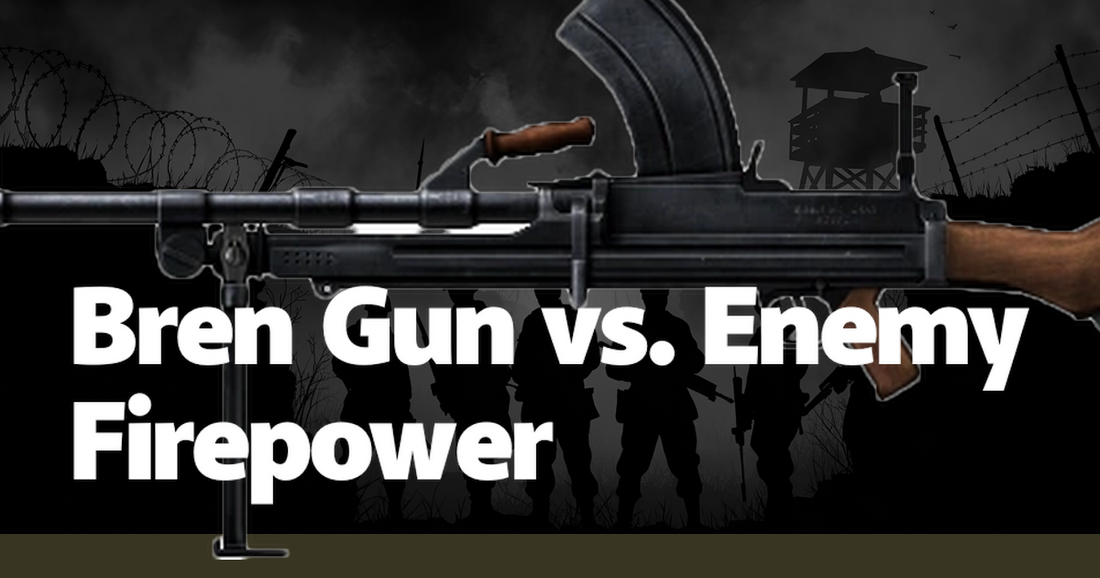In the annals of military history, few weapons have earned as much respect and admiration as the Bren gun. Developed in the 1930s and used extensively by British and Commonwealth forces through World War II and beyond, the Bren, with its distinctive top-mounted magazine, became synonymous with reliable, devastating firepower. The weapon's design, based on the Czech ZB vz. 26, allowed for a high rate of fire and exceptional accuracy, making it a formidable opponent on the battlefield. Its robust construction and ease of use underlined its reputation, but the Bren was not without its challenges, especially when faced with the varied and evolving firepower of enemy forces.
The Bren gun's introduction to combat was met with immediate success. In the North African campaigns, where British forces clashed with the Afrika Korps, the Bren's ability to deliver sustained, accurate fire provided a crucial edge. A well-placed Bren team could lay down suppressive fire, pinning enemy troops and allowing infantry to advance. Anecdotes from veterans recount how the Bren's reliability in harsh desert conditions made it a trusted companion. For instance, during the Battle of El Alamein, Bren gunners played a pivotal role in repelling German counterattacks, their weapons' distinctive chatter a constant reassurance to their comrades.
However, the Bren was not invincible. As the war progressed, enemy forces adapted their tactics and equipment. The German MG 34 and later the MG 42, with their higher rates of fire and larger ammunition capacity, posed significant threats. The MG 42, in particular, could unleash a terrifying 1,200 rounds per minute, far surpassing the Bren's 500 rounds per minute. This disparity in firepower forced Allied troops to rethink their strategies. In the dense hedgerows of Normandy, Bren gunners had to contend with the MG 42's overwhelming suppressive capabilities, often relying on artillery and air support to neutralize entrenched German positions.
Despite these challenges, the Bren gun's versatility and ease of use ensured it remained a staple of British forces. Its bipod and quick-change barrel design allowed for effective use in both offensive and defensive operations. In the Pacific theater, where jungle warfare demanded agility and rapid response, the Bren's portability and reliability shone. Stories from the Burma campaign highlight how Bren teams, often operating in small, isolated units, could hold their own against numerically superior Japanese forces. The weapon's ability to maintain accuracy during prolonged engagements was a key factor in these successes.
The post-war period saw the Bren continue to serve in various conflicts, adapting to new forms of warfare. During the Malayan Emergency, British and Commonwealth forces once again relied on the Bren to combat insurgent tactics. The weapon's durability in the humid, challenging terrain of the Malayan jungles was a testament to its enduring design. Veterans of this conflict often speak of the Bren with a mix of nostalgia and respect, recalling how its presence provided a psychological edge against the elusive enemy.
Comparatively, enemy firepower continued to evolve. The Cold War era introduced a range of new automatic weapons, such as the Soviet RPK and the American M60. Each brought its own advantages and challenges, forcing military strategists to continuously adapt. The Bren, while no longer the cutting-edge weapon it once was, remained relevant through upgrades and modifications. Its transition from .303 British to 7.62mm NATO ammunition allowed it to stay in service alongside newer weapons, a testament to its robust design and adaptability.
In modern times, the legacy of the Bren gun is evident in the continued use of light machine guns in infantry squads. The principles of reliability, accuracy, and ease of use that defined the Bren have influenced the design of contemporary weapons like the FN Minimi and the M249 SAW. These modern counterparts owe much to the lessons learned from the Bren's extensive service history. Military historians and enthusiasts often draw parallels between the Bren and these newer systems, highlighting how the foundational concepts of effective infantry support fire remain unchanged.
Ultimately, the story of the Bren gun vs. enemy firepower is one of evolution and adaptation. While the Bren was a product of its time, designed to meet the specific needs of pre-World War II military doctrine, its continued relevance through multiple conflicts underscores its exceptional design. The interplay between the Bren and its adversaries' firepower is a microcosm of the broader arms race that has defined military history. Each new challenge met by the Bren and its operators provides valuable lessons for the future, ensuring that the principles of effective infantry support fire continue to evolve and adapt to new threats.

